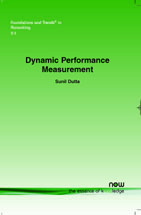Dynamic Performance Measurement
By Sunil Dutta, Walter A. Haas School of Business, University of California, USA, dutta@haas.berkeley.edu
Abstract
This survey advocates the use of dynamic models to examine the incentive properties of commonly used accounting performance metrics. Drawing from recent work in this emerging field, the survey illustrates how one can use tractable multiperiod models to shed light on questions of fundamental interest to accountants. The author first examines the choice of goal congruent performance measures and then explains how the insights obtained from the goal congruent framework can be adapted to second-best contracting in formal agency models. Next, the author builds an analytically tractable multiperiod moral hazard model with a risk averse manager to examine the issue of aggregating accounting and nonaccounting information in constructing optimal performance measures.
Dynamic Performance Measurement
Dynamic Performance Measurement examines alternative performance measures and their ability to align the interests of owners and managers. It advocates and illustrates the use of dynamic models to examine the incentive properties of commonly used accounting performance metrics. Drawing from recent work in this emerging field, this treatise illustrates how one can use tractable multiperiod models to shed light of fundamental interest to accountants.
Dynamic Performance Measurement focuses on the body of research that has reviewed multiperiod models of accrual accounting. The author examines the choice of goal congruent performance measures, explains how the insights obtained from the goal congruent framework can be adapted to second-best contracting in formal agency models, and builds an analytically tractable multiperiod moral hazard model with a risk averse manager to examine the issue of aggregate accounting and non-accounting information in optimal performance measures.
